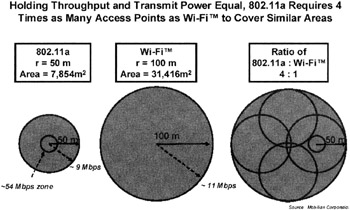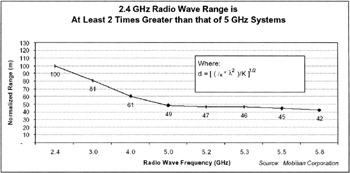Comparing 11a and 11b in an Office Environment
|
| < Day Day Up > |
|
Let's now compare an 802.11a AP to an 820.11b AP in a typical cubicle office environment. A 15 dBm 802.11b AP's transmission and reception will cover a circular area with a radius of approximately 100 meters (328 feet), while providing a maximum 11 Mbps data rate, thus the coverage area would be approximately 37,578 square yards or 31,420 square meters (p* 100m2) at a top data transmission rate of 11 Mbps.
| Note | This example assumes an open office environment and uses the A. Kamerman path loss model that can be found in the paper entitled, "Coexistence between Bluetooth and IEEE 802.11 CCK Solutions to Avoid Mutual Interference," by Lucent Technologies Bell Laboratories, January 1999, also available as IEEE 802.11-00/162, July 2000. |
Now, assuming the RF transmit power and Es/N0 are held constant (i.e. same link budget), an 802.11a AP's coverage equates to a circular area with a radius of roughly 164 feet (50 meters) for a comparable data rate (9 Mbps), equaling a coverage area of approximately 9388 square yards or 7850 square meters. (Note: there are various potential 5 GHz path loss models that show decreased range compared to 2.4 GHz solutions of 45%, 50% and 75%.)
Because of the fundamental difference in signal wave propagation, to achieve similar coverage areas, greater numbers of 802.11a APs are needed to cover the same area that a lesser amount of 802.11b APs could cover. (See Fig. 10.4.) But with the increased number of 802.11a APs, the data rate is only comparable to 802.11b's data rate, not 802.11a's highest data rate of 54 Mbps. This is because (1) the ES/N0 threshold and corresponding bit error rate are more stringent for higher data rate transmit schemes, and (2) energy dissipates as a signal moves away from the transmitter. Thus the further the receiver is from the transmitter, the more difficult it becomes to decipher a message. 802.1 la provides high data rate (36-54 Mbps) levels close to the AP (within about 33-49 feet/10-15 meters), making it attractive for dense user environments that also require high throughput, but its data rates are closer to 9-12 Mbps at ranges over 100-140 feet (30-40 meters).

Figure 10.4: Coverage Comparison of 802.11b and 802.11a. There are significant differences between 11a and 11b in terms of each standard's achievable communication range between the access point and the computing device, and the corresponding service coverage area.
Power Considerations, Relative to Data Rate and Signal Range. You should now understand that 802.11a systems are able to achieve about 50% of the range of 802.11b systems, holding operational variables constant (RF transmit power, receiver sensitivity, etc.), and requiring a data rate approximately equal to 802.11b's 11 Mbps. This limitation in range is caused by the more severe path loss of the 5 GHz spectrum, and the stringent ES/N0 requirements of 802.11a's higher data rate modulation techniques.
Yet, 802.11a systems can achieve data rates similar to 802.11b at ranges approaching those of 11b systems, although to do so requires an increase of approximately four times the RF transmit power of an equivalent 11b system, or from 40mW to approximately 200 mW11. This increase may have a negative impact on the mobile client's (i.e. an end-users' computing device) battery life. But some will argue that at very close ranges (less than 30-45 feet or 9-14 meters in an office environment), an 802.11a computing device will spend less time in transmit mode due to its high data rates, and therefore expend less energy than an 802.11b computing device burdened with similar data traffic amounts.
802.11a's more complex modulation techniques, however, require greater power to maintain a suitable ES/N0. Still, with multiple variables in the equation (environment, data rate, etc.), it is hard to know the breakeven point at which an 802.11a system expends less energy transmitting the same amount of data as an 802.11b system.
Another consideration is the efficiency of the RF power amplifier, which is generally significantly worse for 802.1 la's OFDM relative to 802.11b's PSK12; however, efficiency numbers for OFDM are typically 1/3 of the PSK (phase shift keying) equivalent. As a result, the total power consumption when transmitting 9-12 Mbps OFDM at 5 GHz can be significantly higher than a 2.4 GHz equivalent, even at ranges of only 130-165 feet (40-50 meters).
The end results suggests that an 802.11a system is more power-efficient and may be better suited for transmitting high data rates over small, densely populated areas, while an 802.11b system is more efficient over greater distances. It is interesting to note, however, that OFDM technology in the 2.4 GHz band (i.e. 802.11g) will always surpass its 5 GHz counterpart (i.e. 802.1 la) in power efficiency due to the path loss issue.
Unlicensed Available Spectrum and Spectral Efficiency. All three WLAN standards (802.11a, b and g) use network passbands that cannot overlap, thus limiting the number of simultaneously operating networks to the number of available channels within the unlicensed spectrum, divided by the width of the passband. As the number of WLAN users increases and the bandwidth requirements of applications grow, more WLAN infrastructure must be deployed to support the users, and available throughput must increase. Therefore, the amount of unlicensed spectrum available and the efficiency with which the standard uses the spectrum are important considerations.
The 802.11b specification allows for DSSS (Direct Sequence Spread Spectrum) to break the ISM band into 14 overlapping 22 MHz signal bandwidth channels. (Each operating network requires a single 22 MHz channel.) DSSS provides an 11 Mbps data rate to the network users. Thus the 2.4 GHz band's 83.5 MHz will support three non-overlapping, simultaneously operating 11b networks, with roughly 33 Mbps of data rate (11 Mbps x 3 networks) to be shared among common users across the coverage area. (See Fig. 10.5).

Figure 10.5: Three non-overlapping 802.11b-based networks in the 2.4 GHz band.
This configuration adequately distributes sufficient bandwidth to support the majority of data applications such as word processing, spreadsheets, email, server downloads, PowerPoint presentations, and FTP applications. DSSS cannot adequately support streaming media or large graphic files. However, as user density increases, AP transmit power can be decreased, which effectively serves to increase the number of networks within a given area, and therefore increases the total capacity of the WLAN.
The 802.11a standard requires a 16.6 MHz signal bandwidth channel for one operating network. 11a's modulation technique, OFDM, is more efficient than the spread spectrum techniques that 11b uses (more bits/second/hertz), and provides up to 54 Mbps of data rate to network users. For the U.S.-based 802.11a standard, the 5 GHz unlicensed band covers 300 MHz of spectrum and therefore supports twelve non-overlapping, simultaneously operating networks (See Fig. 10.6).

Figure 10.6: Twelve 802.11a networks in the U.S. 5 GHz band.
Although you can find many sources that cite the figures "648 Mbps of total data rate to distribute across 12 networks (54 Mbps * 12 networks)," it is more likely that common network deployments will support only four simultaneously operating networks in a single area, and provide a 216 Mbps data rate (54 Mbps * 4 networks) within the relatively small range at which 54 Mbps is actually attainable. And, as you have already learned, the further the computing device is from the AP, the lower the attainable data rate.
Nevertheless, 216 Mbps of shared data rate is more than sufficient to support all the office productivity applications mentioned for 802.11b, plus highly bandwidth-intensive applications such as computer-aided design or manufacturing, large distributed databases, and streaming media. But remember, the maximum data rate of 54 Mbps data rate is within a relatively small coverage area. High bandwidth users outside that area would require either more APs for increased coverage, or those users will be subject to reduced throughput.
Thus, 5 GHz solutions are clearly dominant in terms of throughput, spectral efficiency, and available spectrum, but current network deployments and usage models indicate that 802.11b can adequately meet most user needs. When you consider the value of the 802.11g specifications, sticking with 802.11b for the short term may be a good choice. After all, 11g can provide the necessary data rate speed enhancement to allow current 802.11b users to deploy QoS and to access the same high-bandwidth applications that 802.11a users enjoy, while maintaining backward compatibility with legacy 11b networks. But 802.11a can provide greater overall capacity for smaller coverage areas that operate bandwidth intensive applications.
Therefore some WLAN deployments will require a mixed-standard environment in which both 802.11a and 11b-based technologies coexist. High-density, high-bandwidth common areas will be served by 802.11a, e.g. lunchrooms, conference rooms, team rooms, etc. Lower-density, greater coverage areas (e.g. warehouses, corporate office space, etc.) will be served by 802.11b/g-based technologies. Of course, such a mixed-standard environment implies that client devices should be able to roam between 802.1 la and 802.11b/g networks. These dual-mode clients and APs are becoming prevalent.
While the propagation characteristics of the 5GHz band have been studied less extensively than the cellular and PCS bands, there is an adequate body of analysis and measurements to draw from to create useful path loss models.
The physics principle of free space propagation found in Theodore S. Rappaport's Wireless Communications: Principles & Practice (Prentice Hall, 2000) states that as an electromagnetic wave's length grows shorter (i.e., higher frequency), the path loss of that wave increases according to a square law relationship. Also from electromagnetic wave propagation theory, the path loss increases proportionally with the square of the distance between transmitter and receiver in free space. Since 5 GHz radios operate at little over two times the frequency of 2.4 GHz radios, it can be shown that the same link budget can only be sustained over about half the distance as that of a comparable 2.4 GHz system. This is represented by the equation below, but also see Fig. 10.7.

Figure 10.7: Comparative free space path loss between 2.4 GHz and 5 GHz systems.
Ix = K(dN/lx2) [ often expressed in decibels as Ix (db) = KL + 10N log10(d) + 20
log10(fx) ]
OR d = [ ( lx * l2 )/K ]1/N
Where:
lx - path loss
x = frequency band or standard ("a" for 802.11a or "b" for Wi-Fi and 802.1.1g)
K = constant
KL = constant for loss in dB = 32.44 when f is in MHz and d is in kilometers
d = distance
N = attenuation factor: N = 2 for free space; N>2 in most practical environments
l = wavelength
f = frequency = c/l
c = speed of light = 3 x 108 meters/second (free space)
| Note | The Mobilian Corporation, a wireless systems company founded in 1999 to develop highly integrated, multi-standard chips, software, and reference designs supporting multiple wireless radio standards, issued an informative white paper entitled "2.4 GHz and 5 GHz WLAN: Competing or Complementary?," which the author relied upon extensively while writing this section. Additional information comes from the IEEE study of 5 GHz indoor path loss in urban homes, entitled "Measurements and Models for Radio Path Loss and Penetration Loss in and Around Homes and Trees at 5.85 GHz" (G. Durgin, T. S. Rappaport, H. Xu), IEEE Transactions on Communications, Vol. 46, No. 11, November 1998, pp. 1484-1496. |
|
| < Day Day Up > |
|
EAN: 2147483647
Pages: 273